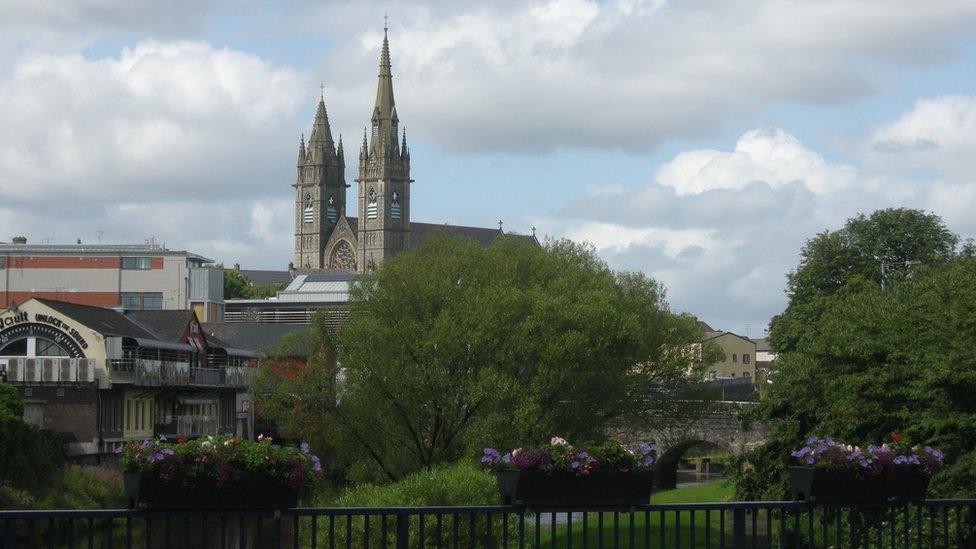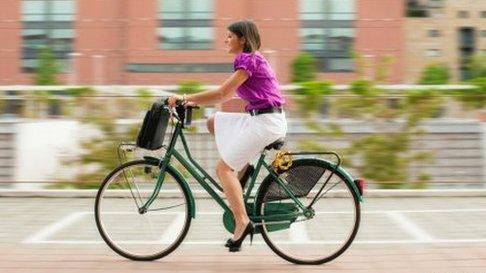Well-being survey: Fermanagh and Omagh 'happiest in UK'
- Published
- comments

The happiest place in the UK is the area of Fermanagh and Omagh in Northern Ireland, a survey has suggested.
Meanwhile, Bolsover in Derbyshire came lowest for happiness, worthiness and life satisfaction.
Pendle in Lancashire had the highest anxiety levels, the Office for National Statistics poll of 165,000 adults said., external
The ONS also warned the data suggested a "growing inequality" between people rating their lives highly and those reporting low levels of well-being.
It said ministers needed to consider how to address this apparent disparity.
Happiest places in the UK
-
1. Fermanagh and Omagh
-
2. Ribble Valley
-
3. Eilean Siar
-
4. West Somerset
-
5. Orkney Islands
Least happy places
-
1. Bolsover
-
2. Cannock Chase
-
3. Dundee City
-
4. Dover
-
5. Liverpool
People were questioned on four measures of well-being: Happiness, life satisfaction, feeling life was worthwhile and anxiety.
The ONS said personal well-being had risen every year since 2011/12 when data was first collected, with the greatest improvement for levels of anxiety.
But the proportion of people giving the highest ratings for well-being increased "significantly" in the financial year to 2015, while the decreases in low well-being "were small" in comparison.
"It indicates that while improvements are widespread across the population, they are uneven," said the ONS.
'Lower well-being in London'
Northern Ireland recorded higher average ratings for well-being for all measures except anxiety, which the ONS says has been the case for the past four years.
Wales was the only country to not have any significant improvement in the last financial year, according to the ONS.
Londoners reported lower well-being than the UK averages, but has seen improvements in each of the four measures since the survey was first carried out.

Omagh, County Tyrone, where residents are said to be the happiest
The 2014/15 study asked how happy people felt the previous day, with zero meaning "not at all happy" and 10 "completely happy".
Those in the district of Fermanagh and Omagh, which covers most of south-west Northern Ireland and includes rural areas as well as the towns of Enniskillen and Omagh, gave an average score of 8.26.
Those in the Ribble Valley, Lancashire, which includes the market towns of Clitheroe and Longridge as well as part of the Forest of Bowland, scored second highest with 8.21.
Eilean Siar in the Outer Hebrides, one of the most remote areas of the UK, scored 8.15.


Where would you be happiest? Take the BBC iWonder test here to find out.

Meanwhile, the bottom of the table was the largely rural area of Bolsover, which used to have one of the biggest concentrations of coalmines in the country, with 6.89.
It was followed by Cannock Chase, Staffordshire, an area of woodland and heathland which is the smallest designated Area of Outstanding Beauty in Britain, on 6.92 and Dundee City, Scotland's fourth largest city, on 7.02.
Asked how anxious they felt, residents of Pendle, Lancashire, which borders Yorkshire and has the UK's second highest percentage of the workforce employed in manufacturing, scored the highest with 3.58.
They were followed by Greenwich, south-east London, on 3.55 and Lisburn and Castlereagh, Northern Ireland, on 3.52.
The least anxious places were Nuneaton and Bedworth, in Warwickshire, with 1.84, Rushmoor, Hampshire, on 2.01, and Boston, Lincolnshire, on 2.06.
The Dalai Lama has given his blessing to mindfulness classes
Eilean Siar scored top for life satisfaction, on 8.41, and was also fourth highest for feeling the things residents do in the lives are worthwhile, with a score of 8.47.
West Somerset gave the highest score for feeling worthwhile, on 8.58, followed by Staffordshire Moorlands on 8.58 and Mid Ulster on 8.48.
Glenn Everett, ONS director of well-being, said: "Overall, people are generally rating their lives higher than they did four years ago.
"But what is interesting is that they show a slight growth in inequality between people rating their lives highly and those reporting low levels of personal well-being... a growing inequality that policy makers need to consider."
- Published24 September 2014

- Published24 April 2015

- Published21 September 2015
- Published14 September 2014
